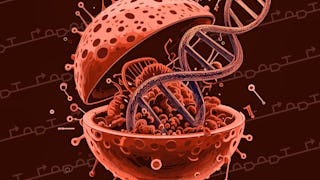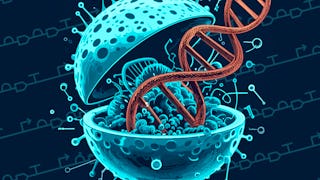This course gives an introduction to how to create genetic circuit models. These models leverage chemical reactions represented using the Systems Biology Markup Language (SBML). The second module introduces methods to simulate these models using ordinary differential equation (ODE) methods. The third module teach stochastic simulation methods. The fourth module introduces several variations of the stochastic simulation algorithm. Finally, the fifth module introduces genetic technology method that leverage computational analysis for selecting parts and verifying their performance.

Entdecken Sie neue Fähigkeiten mit 30% Rabatt auf Kurse von Branchenexperten. Jetzt sparen.


Engineering Genetic Circuits: Modeling and Analysis
Dieser Kurs ist Teil von Spezialisierung für Engineering Genetic Circuits


Dozenten: Chris Myers
Bei  enthalten
enthalten
Empfohlene Erfahrung
Was Sie lernen werden
Design and analyze models of genetic circuits.
Simulate genetic circuit models using ODE simulation methods.
Simulate genetic circuit models using stochastic simulation methods.
Utilize genetic technology mappers to select parts for genetic designs.
Kompetenzen, die Sie erwerben
- Kategorie: Computational Logic
- Kategorie: Algorithms
- Kategorie: Software Visualization
- Kategorie: Molecular, Cellular, and Microbiology
- Kategorie: Mathematical Modeling
- Kategorie: Engineering Analysis
- Kategorie: Chemical and Biomedical Engineering
- Kategorie: Simulations
- Kategorie: Bioinformatics
- Kategorie: Differential Equations
Wichtige Details

Zu Ihrem LinkedIn-Profil hinzufügen
16 Aufgaben
Erfahren Sie, wie Mitarbeiter führender Unternehmen gefragte Kompetenzen erwerben.

Erweitern Sie Ihre Fachkenntnisse
- Lernen Sie neue Konzepte von Branchenexperten
- Gewinnen Sie ein Grundverständnis bestimmter Themen oder Tools
- Erwerben Sie berufsrelevante Kompetenzen durch praktische Projekte
- Erwerben Sie ein Berufszertifikat zur Vorlage

In diesem Kurs gibt es 5 Module
This week will describe the basics of modeling biological systems using chemical reactions, how these models can be represented using the Systems Biology Markup Language (SBML) standard, and how these models can be constructed using software tools such as iBioSim.
Das ist alles enthalten
23 Videos7 Lektüren2 Aufgaben1 peer review
This module will introduce the theory and methods for the analysis of genetic circuit models using ordinary differential equations (ODEs). In particular, it will describe the classical chemical kinetic model, numerical methods for ODE simulation of these models, and techniques to analyze these ODE models qualitatively.
Das ist alles enthalten
13 Videos3 Lektüren3 Aufgaben1 peer review
This module will introduce stochastic analysis methods for genetic circuits. In particular, it will introduce the stochastic chemical kinetics model, Gillespie's Stochastic Simulation Algorithm (SSA) to analyze these models, and various alternative stochastic analysis methods. Finally, the module will conclude with some additional topics: the Chemical Langevin Equation, stochastic Petri nets, the phage lambda model, and spatial Gillespie methods.
Das ist alles enthalten
20 Videos4 Lektüren4 Aufgaben1 peer review
This module presents several variations on the SSA algorithm to solve particular analysis problems. In particular, the hierarchical SSA (hSSA) methods enable the analysis of large models, the weighted SSA (wSSA) methods allow for the analysis of rare events, and the incremental SSA (iSSA) methods enable the determination of typical behaviors.
Das ist alles enthalten
18 Videos4 Lektüren3 Aufgaben
This module presents various ways that modeling can be utilized in genetic circuit design to select parts for optimal performance.
Das ist alles enthalten
21 Videos4 Lektüren4 Aufgaben
Erwerben Sie ein Karrierezertifikat.
Fügen Sie dieses Zeugnis Ihrem LinkedIn-Profil, Lebenslauf oder CV hinzu. Teilen Sie sie in Social Media und in Ihrer Leistungsbeurteilung.
Auf einen Abschluss hinarbeiten
Dieses Kurs ist Teil des/der folgenden Studiengangs/Studiengänge, die von University of Colorado Boulderangeboten werden. Wenn Sie zugelassen werden und sich immatrikulieren, können Ihre abgeschlossenen Kurse auf Ihren Studienabschluss angerechnet werden und Ihre Fortschritte können mit Ihnen übertragen werden.¹
Dozenten


Mehr von Electrical Engineering entdecken
 Status: Kostenloser Testzeitraum
Status: Kostenloser TestzeitraumUniversity of Colorado Boulder
 Status: Kostenloser Testzeitraum
Status: Kostenloser TestzeitraumUniversity of Colorado Boulder
 Status: Kostenloser Testzeitraum
Status: Kostenloser TestzeitraumUniversity of Colorado Boulder
 Status: Kostenloser Testzeitraum
Status: Kostenloser TestzeitraumIcahn School of Medicine at Mount Sinai
Warum entscheiden sich Menschen für Coursera für ihre Karriere?





Neue Karrieremöglichkeiten mit Coursera Plus
Unbegrenzter Zugang zu 10,000+ Weltklasse-Kursen, praktischen Projekten und berufsqualifizierenden Zertifikatsprogrammen - alles in Ihrem Abonnement enthalten
Bringen Sie Ihre Karriere mit einem Online-Abschluss voran.
Erwerben Sie einen Abschluss von erstklassigen Universitäten – 100 % online
Schließen Sie sich mehr als 3.400 Unternehmen in aller Welt an, die sich für Coursera for Business entschieden haben.
Schulen Sie Ihre Mitarbeiter*innen, um sich in der digitalen Wirtschaft zu behaupten.
Häufig gestellte Fragen
To access the course materials, assignments and to earn a Certificate, you will need to purchase the Certificate experience when you enroll in a course. You can try a Free Trial instead, or apply for Financial Aid. The course may offer 'Full Course, No Certificate' instead. This option lets you see all course materials, submit required assessments, and get a final grade. This also means that you will not be able to purchase a Certificate experience.
When you enroll in the course, you get access to all of the courses in the Specialization, and you earn a certificate when you complete the work. Your electronic Certificate will be added to your Accomplishments page - from there, you can print your Certificate or add it to your LinkedIn profile.
If you subscribed, you get a 7-day free trial during which you can cancel at no penalty. After that, we don’t give refunds, but you can cancel your subscription at any time. See our full refund policy.
Weitere Fragen
Finanzielle Unterstützung verfügbar,

